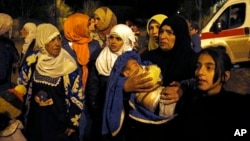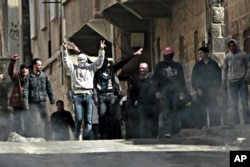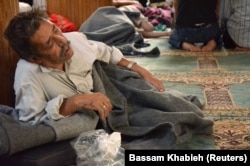Negotiators meeting for Syrian peace talks that began Friday in Geneva are focusing on urgent goals: establishing a cease-fire, delivering humanitarian aid, and setting a course for long-term resolution of the nearly five-year conflict.
They’re also confronting a crisis years in the making, rife with deep sectarian divisions, clashing regional and international interests, and a rising threat from the radical Islamic State militant group that has exploited Syria’s instability.
What sparked the crisis?
In March 2011, a popular uprising began against Syrian President Bashar al-Assad’s authoritarian regime after the arrest, and alleged torture, of more than a dozen youngsters in the southern city of Daraa. They’d scribbled anti-government slogans on a wall. Protesters took to the streets, demanding the youngsters’ release – as well as sweeping political reforms.
The government made some concessions – repealing a restrictive emergency law, for instance – but also responded with a bloody military crackdown, initially killing four demonstrators. Unrest spread from that flashpoint city, along with demands for Assad’s resignation. Rebel groups took up arms.
Since then, the conflict has left more than 250,000 people dead in Syria and displaced as many as 11 million others from a prewar population of about 22 million. Of those, at least 4 million have fled to neighboring countries. Tens of thousands have risked harrowing journeys to seek refuge in Europe, fueling a migrant crisis there.
Who’s involved in the conflict?
There are multiple players and multiple spheres – local, regional and international. (The Financial Times news site sorts them out, along with their complicated allegiances, in graphic form.)
Assad belongs to Syria’s ruling Alawite religious minority, a largely secular offshoot of Shia Islam. Regionally, Assad’s government is closely allied with heavily Shi’ite Iran and with neighboring Hezbollah in Lebanon. Support for Assad and the Syrian army has come from Iran’s Revolutionary Guards, Hezbollah and Russian airstrikes.
The opposition in Syria includes many Sunni Islamist rebel groups as well as secular ones. They include Kurds, the largest ethnic minority in the predominantly Arab country. The main Sunni and Kurdish groups collaborate in fighting not only the Assad regime but also IS militants. The opposition has the backing of the West, including the United States and the European Union.
Syria historically has been a bastion of religious tolerance in the Middle East, with Muslim sects, Christians and Jews living in close proximity, the On Faith website points out in examining faith’s role in the conflict.
What are some of the key developments?
Initially, in late April 2011, the Obama administration imposed sanctions on Syria’s intelligence agency and two of Assad’s relatives – and pressed for European allies to use their greater influence to halt the bloodshed. That August, Obama called for Assad’s resignation.
By October 2012, the U.S. had given $200 million in humanitarian aid and $50 million to assist unarmed opposition groups. The following August, Obama sought congressional authorization to use military force against Syria.
US Involvement in Syria
April 29, 2011: U.S. sanctions Syria’s intelligence agency for Syria’s crackdown on “Arab Spring” anti-government protests.
Aug. 28, 2011: U.S. President Barack Obama calls for Syrian President Bashar al-Assad to leave office.
Aug. 20, 2012: Obama warns Assad against using chemical weapons in the conflict.
April 2013: Abu Bakr al-Baghdadi announces the formation of the Islamic State in Iraq and the Levant (IS), an Islamic militant group.
March 2013: Syria bombs the rebel-held northern city of Raqqa. The U.S. and Britain promise nonlethal support for moderate rebels.
Aug. 30, 2013: The U.S. condemns the Syrian government for reportedly gassing roughly hundreds of “women and children and innocent civilians.”
Aug. 31, 2013: Obama seeks congressional authorization to use military force against Syria.
September 2013: UN weapons inspectors verify chemical weapons killed roughly 300 people in Damascus.
December 2013: After IS fighters seize warehouses used by the Western-backed Free Syrian Army rebels, U.S. suspends aid.
June 2014: IS militants seize Mosul and Tikrit in Iraq and announce plans to establish a caliphate.
August 8, 2014: Obama authorizes “targeted airstrikes,” with two rounds of attacks hitting IS targets in northwestern Iraq.
Aug. 20, 2014: IS releases a video showing the beheading of American journalist James Foley, 40, kidnapped a year earlier in northern Syria. His executioner warns the U.S. government that trying “to deny the Muslims their rights of living in safety under the Islamic caliphate will result in the bloodshed of your people.”
Sept. 2, 2014: IS releases a video showing the decapitation of American journalist Steven Sotloff, kidnapped in August 2013 near Aleppo, Syria.
Sept. 22, 2014: A U.S.-led coalition – including Bahrain, Jordan, Qatar, Saudi Arabia and the United Arab Emirates – begins a campaign of airstrikes against IS targets in Syria.
Feb. 10, 2015: U.S. officials confirm the death of American aid worker Kayla Mueller, 26. Kidnapped in Aleppo in August 2013, she reportedly had been held by IS senior member Abu Sayyaf in eastern Syria and was repeatedly raped by IS leader Baghdadi. IS claims Mueller died Feb. 6 in a weapons warehouse near Raqqa.
May 16, 2015: U.S. Special Operations forces kill Sayyaf and capture his wife, Umm Sayyaf, in a ground raid in eastern Syria.
May 20, 2015: IS militants seize control of most of Palmyra, a central Syrian city with 2,000-year-old ruins designated a UNESCO World Heritage Site. IS militants subsequently destroy two Roman-era temples.
September 30, 2015: Russia begins airstrikes in support of Syria’s Assad government. Moscow claims the campaign targets IS, but the Pentagon and Western officials note Western-backed rebels are also hit.
Oct. 30, 2015: Obama authorizes fewer than 50 U.S. special operations forces to coordinate movements of Syrian local fighters with the U.S.-led coalition.
Reuters news agency contributed to this report.
In April 2013, the militant extremist group Islamic State of Iraq and the Levant emerged, an outgrowth of al-Qaida, and by early 2014 it had seized the Syrian city of Raqqa, establishing it as the capital of its planned caliphate.
In May 2013, the UN General Assembly voted to condemn Assad’s forces, citing "grave concern" at Syrian authorities’ threat or actual use of chemical or biological weapons. Assad’s forces repeatedly have denied accusations of attacking civilians with sarin nerve gas and barrel bombs. Chemical weapons were used in subsequent attacks August 21 on several Damascus suburbs, U.N. inspectors later noted in a report that did not assign blame. But a White House report said the U.S. intelligence community had "high confidence" that Assad’s government was responsible for the chemical attacks, which killed an estimated 1,429 people. The Organization for the Prohibition of Chemical Weapons, which won the Nobel Peace Prize for its efforts to destroy Syria’s chemical weapons arsenal.
In September 2014, after territorial gains by the Islamic State and confirmation that the group had beheaded two American journalists, the United States formed a multinational coalition and launched a bombing campaign against IS targets in Syria.
In late September 2015, Russia began its own airstrikes in Syria. The Kremlin said it was bombing IS targets, but its warplanes have repeatedly attacked other Assad opponents, including allies of the U.S.-led coalition.
What’s next?
Syrian peace talks began Friday afternoon despite a boycott by several anti-Assad groups, including the Saudi-backed High Negotiations Committee. Rebels had set a condition of halting airstrikes and sieges on towns before they would participate in talks. They said they were focused on fighting off the Syrian government forces closing in on their ranks in the Damascus suburbs.
Also missing from the table were Kurds, who – despite showing effective fighting skills against Islamic State – were excluded at Turkey’s insistence, Reuters news service reported. But a delegation from the Syrian government was there.
Given the sensitivities of talks, U.N. organizers said they’re holding indirect "proximity talks," meeting with some stakeholders in separate rooms.











